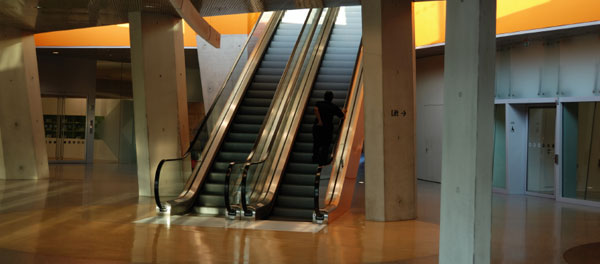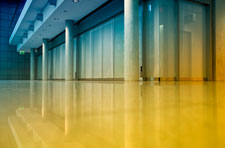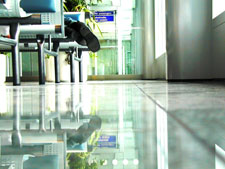A Lasting Shine: Moisture Measurement for Polished Concrete

So where does concrete moisture come from? How can you be sure the slab is dry enough to proceed before you start the finishing process?
Has the Slab Finished Drying?
Concrete moisture begins as the water that is part of each batch mix and is necessary for the hydration process of concrete. Too much, and the concrete will take longer to dry and possibly be structurally weaker. Too little, and cracks, flaking and difficulty troweling it to the right finish will result.
It’s important to note, however, that batch water is not the only place that concrete moisture can come from. Without adequate drainage or properly-installed moisture barriers, ground water can enter a slab from the underside. Leaking plumbing or appliances can be a source of slab moisture. Even high ambient relative humidity can be a source of elevated moisture levels in a slab.
 How can you be sure the internal moisture content is compatible with the end finish for the concrete floor?
How can you be sure the internal moisture content is compatible with the end finish for the concrete floor?
To begin, an understanding of the process in drying concrete is necessary. When concrete is first poured (and assuming it will be drying from one surface), the moisture in the concrete tends to have a gradient distribution through the slab; less on the top, more on the bottom.
This is entirely logical when you think about it – concrete dries as the moisture evaporates out of the slab and into the surrounding air. As that moisture moves away, more rises to the surface through the natural spaces between the aggregate particles and cement particles.
This process will continue until the moisture levels in the slab reach a balance with the humidity levels of its immediate environment. (It’s also true that if the ambient RH level is higher than the slab’s moisture level, the slab can actually absorb moisture through an exposed surface.)
Once the slab is sealed, the moisture continues to move through the slab until the moisture levels (or MC) are evenly distributed within the slab.
Understanding this process also demonstrates why surface-based moisture testing of any kind cannot give an accurate indication of the final moisture levels in a drying concrete slab.
Fortunately, in the past few decades of scientific concrete moisture testing, it has been proven that the relative humidity (RH) level of a concrete slab drying from one surface at 40% of its depth is an accurate predictor of the final moisture levels in the slab if the slab were to be sealed at that point in time.
A test method called relative humidity (RH) testing, or in situ testing, was developed that places a sensor or probe at that specific depth in a slab to determine the equilibrated moisture levels. RH testing can determine if a slab is “dry enough” to meet the specs of the flooring finish or material specified.
Burnishing and Polishing Concrete: The Risks
 Polishing a concrete floor generally consists of at least two separate processes: burnishing and polishing.
Polishing a concrete floor generally consists of at least two separate processes: burnishing and polishing.
Burnishing is meant to give a smooth, durable surface by removing trace trowel marks, stain, pits, or even previous coatings from the slab surface.
It is actually a grinding process, not a polishing process, which uses a hard abrasive (often diamond grit) to eliminate pits or surface imperfections. Generally, a slab (a new slab in particular) has a rougher surface that needs to be refined before the final finish process.
The challenge is that often the process that can grind the surface “open” – meaning it leaves the fine capillaries that allow moisture to escape the slab open – can actually have the opposite effect. As dust and residue get ground into the surface through the burnishing process, those openings in the concrete’s surface can become plugged.
Polishing is the final stage of the flooring finish; it can give the concrete slab its distinctive luster or a high-gloss shine, depending on the grit of the polishing disks and the desired final result.
Polishing carries the same risk of sealing the pores of the slab, and to complicate matters further, often a polishing sealer is applied at this stage, which is absorbed by the slab and acts as a substitute for a topical coating.
Both burnishing and polishing increase the possibility that excess moisture will be trapped under the sealed surface. Over time, that moisture will result in finish failures, discolorations, cracks or scaling.
Finish Strong
So how can you best protect that shiny finished floor? With accurate, reliable RH testing, like with the Rapid RH®, performed before the finish process is executed.
Only by accurately determining the internal moisture levels of a concrete slab can you accurately predict the ultimate success or failure of a flooring material or finish.
Surface-based testing may provide a short-term indication of moisture at the top of the slab, but ultimately the entire moisture content of any slab will equilibrate, and the moisture that started as more concentrated from bottom to less concentrated at the surface will disperse to levels that are equal across the slab, including at the surface.
If that final moisture level is outside the normal tolerances of the applied finish, you can be sure that at some point you’ll be called back for remediation work.
Only RH testing can give the flooring finisher the accurate, endgame, RH measurements necessary to polish that concrete floor to a smooth, lasting shine.